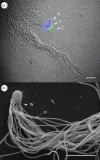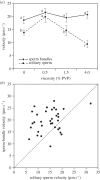Team swimming in ant spermatozoa
- PMID: 24919705
- PMCID: PMC4090553
- DOI: 10.1098/rsbl.2014.0308
Team swimming in ant spermatozoa
Abstract
In species where females mate promiscuously, competition between ejaculates from different males to fertilize the ova is an important selective force shaping many aspects of male reproductive traits, such as sperm number, sperm length and sperm-sperm interactions. In eusocial Hymenoptera (bees, wasps and ants), males die shortly after mating and their reproductive success is ultimately limited by the amount of sperm stored in the queen's spermatheca. Multiple mating by queens is expected to impose intense selective pressure on males to optimize the transfer of sperm to the storage organ. Here, we report a remarkable case of cooperation between spermatozoa in the desert ant Cataglyphis savignyi. Males ejaculate bundles of 50-100 spermatozoa. Sperm bundles swim on average 51% faster than solitary sperm cells. Team swimming is expected to increase the amount of sperm stored in the queen spermatheca and, ultimately, enhance male posthumous fitness.
Keywords: ants; sexual selection; sperm cooperation.
© 2014 The Author(s) Published by the Royal Society. All rights reserved.
Figures


Similar articles
-
Rival seminal fluid induces enhanced sperm motility in a polyandrous ant.BMC Evol Biol. 2018 Mar 23;18(1):28. doi: 10.1186/s12862-018-1144-y. BMC Evol Biol. 2018. PMID: 29566664 Free PMC article.
-
Antibacterial activity of male and female sperm-storage organs in ants.J Exp Biol. 2018 Mar 26;221(Pt 6):jeb175158. doi: 10.1242/jeb.175158. J Exp Biol. 2018. PMID: 29444845
-
Impact of immune activation on stored sperm viability in ant queens.Proc Biol Sci. 2018 Dec 19;285(1893):20182248. doi: 10.1098/rspb.2018.2248. Proc Biol Sci. 2018. PMID: 30963911 Free PMC article.
-
Long-term sperm storage in eusocial Hymenoptera.Biol Rev Camb Philos Soc. 2023 Apr;98(2):567-583. doi: 10.1111/brv.12919. Epub 2022 Nov 17. Biol Rev Camb Philos Soc. 2023. PMID: 36397639 Review.
-
Implications of diversity in sperm size and function for sperm competition and fertility.Int J Dev Biol. 2008;52(5-6):439-47. doi: 10.1387/ijdb.082595mg. Int J Dev Biol. 2008. PMID: 18649256 Review.
Cited by
-
Methodological considerations for examining the relationship between sperm morphology and motility.Mol Reprod Dev. 2020 Jun;87(6):633-649. doi: 10.1002/mrd.23346. Epub 2020 May 16. Mol Reprod Dev. 2020. PMID: 32415812 Free PMC article. Review.
-
Collective dynamics of sperm cells.Philos Trans R Soc Lond B Biol Sci. 2020 Sep 14;375(1807):20190384. doi: 10.1098/rstb.2019.0384. Epub 2020 Jul 27. Philos Trans R Soc Lond B Biol Sci. 2020. PMID: 32713305 Free PMC article. Review.
-
Rival seminal fluid induces enhanced sperm motility in a polyandrous ant.BMC Evol Biol. 2018 Mar 23;18(1):28. doi: 10.1186/s12862-018-1144-y. BMC Evol Biol. 2018. PMID: 29566664 Free PMC article.
-
Modelling Motility: The Mathematics of Spermatozoa.Front Cell Dev Biol. 2021 Jul 20;9:710825. doi: 10.3389/fcell.2021.710825. eCollection 2021. Front Cell Dev Biol. 2021. PMID: 34354994 Free PMC article. Review.
-
The ancient and helical architecture of Elasmobranchii's spermatozoa enables progressive motility in viscous environments.PLoS One. 2025 Feb 25;20(2):e0319354. doi: 10.1371/journal.pone.0319354. eCollection 2025. PLoS One. 2025. PMID: 39999125 Free PMC article.
References
-
- Parker GA. 1970. Sperm competition and its evolutionary consequences in insects. Biol. Rev. 45, 525–567. (10.1111/j.1469-185X.1970.tb01176.x) - DOI
-
- Birkhead TR, Møller AP. 1998. Sperm competition and sexual selection. London, UK: Academic Press.
-
- Simmons LW. 2001. Sperm competition and its evolutionary consequences in the insects. Princeton, NJ: Princeton University Press.
-
- Wilson EO. 1971. The insect societies. Cambridge, UK: Belknap Press.
Publication types
MeSH terms
LinkOut - more resources
Full Text Sources
Other Literature Sources

